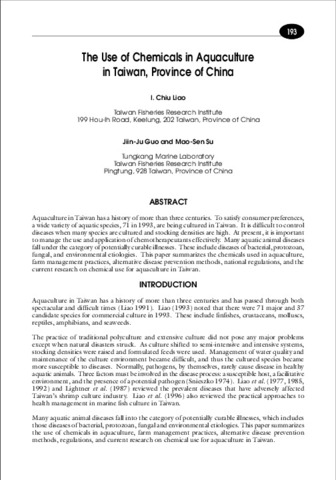Chlorine disinfection against hepatopancreatic parvovirus (HPV) infection in shrimp (Penaeus monodon) larvae
- Global styles
- MLA
- Vancouver
- Elsevier - Harvard
- APA
- Help

Date
2005-03Page views
2,047ASFA keyword
AGROVOC keyword
Taxonomic term
Metadata
Show full item record
Share
Abstract
Experiments were undertaken to determine the efficacy of chlorine as a disinfectant in inhibiting HPV infection among P. monodon postlarvae (PLs). Based on histopathological examination, 50 ppm and 200 ppm active chlorine at two different exposure durations (12 and 24 hr), failed to inhibit the transmission of HPV in the experimental PLs. Higher chlorine concentrations, 500 ppm and 1,000 ppm for 24 hr exposure, decreased percentage of HPV infection, but failed to completely inhibit the transmission of the virus in PLs.
It is recommended that other disinfecting agents be tested as HPV appears to be resistant to chlorine. Also, the experimental design should be modified in order to actually simulate existence of HPV as an infectious agent in hatchery conditions.
Suggested Citation
Catap, E. S., & de la Peña, L. D. (2005). Chlorine disinfection against hepatopancreatic parvovirus (HPV) infection in shrimp (Penaeus monodon) larvae. In K. Nagasawa (Ed.), Recent Advances in Diagnosis and Prevention of Fish and Shrimp Diseases in Southeast Asia (pp. 51–57). Tigbauan, Iloilo, Philippines: Aquaculture Department, Southeast Asian Fisheries Development Center.
Type
Book chapterISBN
9718511732
Related items
Showing items related by title, author, creator and subject.
-
[The Philippines recommends for mangrove crab:] Hatchery operations
The Mangrove Crab Technical Committee 2018 (DOST-PCAARRD, 2021) -
The use of chemicals in aquaculture in Thailand
Tonguthai, Kamonporn (Aquaculture Department, Southeast Asian Fisheries Development Center, 2000)In Thailand, many chemicals are used to treat diseases of cultured aquatic animals and to improve water quality in culture facilities. Along with the intensification of aquaculture practices that has occurred in recent ... -
The use of chemicals in aquaculture in Taiwan, Province of China
Liao, I. Chiu; Guo, Jiin Ju; Su, Mao-Sen (Aquaculture Department, Southeast Asian Fisheries Development Center, 2000)Aquaculture in Taiwan has a history of more than three centuries. To satisfy consumer preferences, a wide variety of aquatic species, 71 in 1993, are being cultured in Taiwan. It is difficult to control diseases when many ...

 AQD Access
AQD Access




